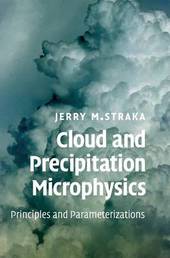
|
Cloud and Precipitation Microphysics: Principles and Parameterizations
Hardback
Main Details
| Title |
Cloud and Precipitation Microphysics: Principles and Parameterizations
|
| Authors and Contributors |
By (author) Jerry M. Straka
|
| Physical Properties |
| Format:Hardback | | Pages:408 | | Dimensions(mm): Height 244,Width 170 |
|
| Category/Genre | Meteorology and climatology |
|---|
| ISBN/Barcode |
9780521883382
|
| Classifications | Dewey:551.57 |
|---|
| Audience | | Professional & Vocational | |
|---|
|
Publishing Details |
| Publisher |
Cambridge University Press
|
| Imprint |
Cambridge University Press
|
| Publication Date |
11 June 2009 |
| Publication Country |
United Kingdom
|
Description
This book focuses specifically on bin and bulk parameterizations for the prediction of cloud and precipitation at various scales - the cloud scale, mesoscale, synoptic scale, and the global climate scale. It provides a background to the fundamental principles of parameterization physics, including processes involved in the production of clouds, ice particles, liquid water, snow aggregate, graupel and hail. It presents full derivations of the parameterizations, allowing readers to build parameterization packages, with varying levels of complexity based on information in the book. Architectures for a range of dynamical models are given, in which parameterizations form a significant tool for investigating large non-linear numerical systems. Model codes are available online at www.cambridge.org/9780521883382. Written for researchers and advanced students of cloud and precipitation microphysics, this book is also a valuable reference for all atmospheric scientists involved in models of numerical weather prediction.
Author Biography
Jerry M. Straka received a Ph.D. in Meteorology from the University of Wisconsin, Madison in 1989. He then worked for a short time at the University of Wisconsin's Space Science and Engineering Center (SSEC) in Madison before joining the University of Oklahoma in 1990 where he is an Associate Professor of Meteorology. Dr Straka's research interests include microphysical modeling, severe thunderstorm dynamics, numerical prediction, radar meteorology, and computational fluid dynamics. He is co-director of the Verifications of the Origins of Rotation in Tornadoes Experiment (VORTEX I) and a Member of the American Meteorological Society.
|